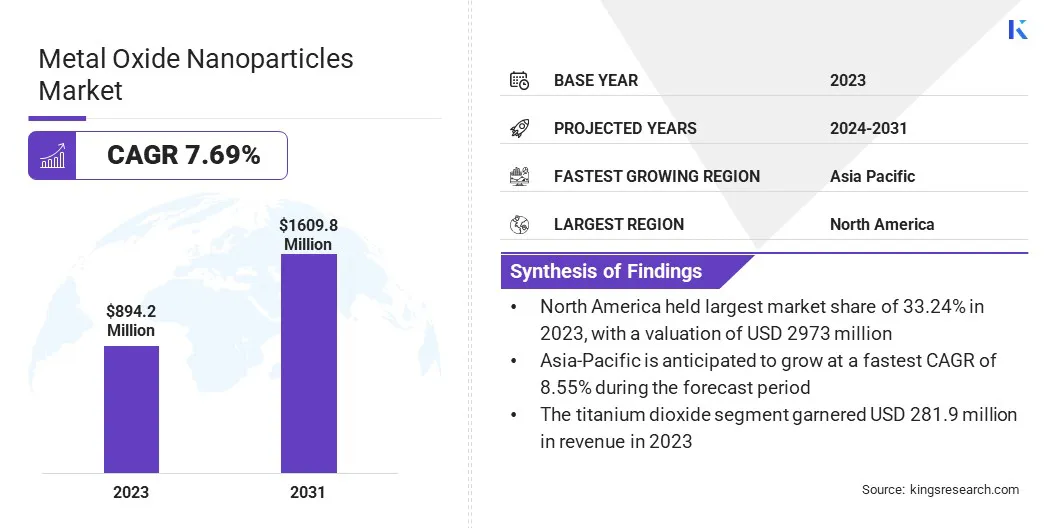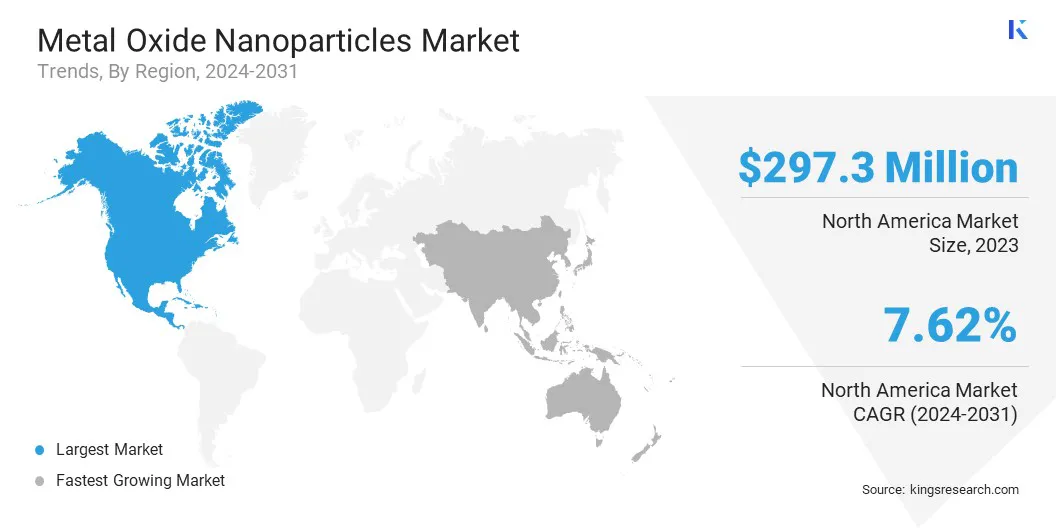Market Definition
The market focuses on the production, distribution, and application of nanoscale metal oxide particles, typically ranging from 1 to 100 nanometers in size. These nanoparticles exhibit exceptional optical, electrical, magnetic, and catalytic properties, making them highly valuable across diverse industries.
These nanoparticles, including titanium dioxide, zinc oxide, aluminum oxide, and iron oxide, are valued for their high surface area, enhanced reactivity, and superior mechanical strength.
Metal Oxide Nanoparticles Market Overview
The global metal oxide nanoparticles market size was valued at USD 894.2 million in 2023 and is projected to grow from USD 958.1 million in 2024 to USD 1609.8 million by 2031, exhibiting a CAGR of 7.69% during the forecast period.
Market growth is driven by increasing demand across various industries, including electronics, healthcare, energy, and environmental applications. The rising adoption of metal oxide nanoparticles in pharmaceuticals, coatings, and renewable energy solutions further fuels expansion.
Major companies operating in the metal oxide nanoparticles industry are American Elements., EPRUI Biotech Co., Ltd., Altairnano, Meliorum Technologies, Inc., Nanoshell LLC, US Research Nanomaterials, Inc., Hongwu International Group Ltd, Star Grace Mining Co., Ltd, SkySpring Nanomaterials, Inc., Nanorh, NYACOL Nano Technologies Inc., Merck KGaA, Adnano Technologies Private Limited, Techinstro., and Cytodiagnostics Inc.
Advancements in nanotechnology, coupled with growing research and development activities, are enhancing the performance and functionality of these nanoparticles. Additionally, the rising emphasis on sustainable and eco-friendly materials is fostering innovations in green synthesis methods.
The growing use of metal oxide nanoparticles in antimicrobial coatings, fuel cells, and water purification further supports market expansion. Continuous innovations, increasing industrial adoption, and expanding applications in emerging sectors are expected to propel market expansion.
- In December 2023, the Press Information Bureau reported that the development of a cost-effective sensor using a metal oxide nanoparticles–reduced graphene oxide composite to non-invasively detect formalin adulteration in fish at room temperature. This lab-stage prototype marks a significant advancement in food safety, potentially boosting demand for metal oxide nanoparticles in advanced sensing applications and creating new growth opportunities for affordable formalin detection devices.

Key Highlights
- The metal oxide nanoparticles industry size was recorded at USD 894.2 million in 2023.
- The market is projected to grow at a CAGR of 7.69% from 2024 to 2031.
- North America held a share of 33.24% in 2023, valued at USD 297.3 million.
- The titanium dioxide segment garnered USD 281.9 million in revenue in 2023.
- The optics & electronics segment is expected to reach USD 431.5 million by 2031.
- Asia Pacific is anticipated to grow at a CAGR of 8.55% over the forecast period.
Market Driver
"Expanding Applications in Healthcare & Biomedical Fields"
Surging use of metal oxide nanoparticles, including zinc oxide (ZnO), titanium dioxide (TiO₂), iron oxide (Fe₂O₃), and cerium oxide (CeO₂), in healthcare is driving market expansoon due to their antimicrobial, biocompatible, and drug delivery properties.
They enhance targeted therapy, MRI imaging, and medical coatings, while zinc oxide and titanium dioxide provide UV protection in sunscreens. Their use in wound dressings, sterilization, and diagnostics continues to expand with advancements in nanomedicine and regenerative medicine, strengthening their role in the biomedical sector.
The increasing emphasis on nanomedicine, regenerative medicine, and personalized healthcare is set to further strenghthen their role in the biomedical sector, supporting sustained market expansion.
- In March 2023, the National Institutes of Health published an article in Frontiers in Chemistry on metal oxide nanoparticles (MO-NPs). The study examines their structural properties, various synthesis methods, and applications in environmental remediation. It highlights their effectiveness in wastewater treatment, particularly in removing pesticides and heavy metals through adsorption and photocatalytic degradation.
Market Challenge
"Regulatory and Safety Concerns"
Regulatory and safety concerns pose a significant challenge to the progress of the metal oxide nanoparticles market due to potential toxicity, bioaccumulation, and environmental impact.
The lack of long-term toxicity data and uncertainties in nanoparticle interactions with biological systems complicate approvals. Companies must conduct extensive testing, risk assessments, and compliance measures, delying commercialization and increasing costs.
To address this challenge, the implementation of eco-friendly synthesis methods, such as green chemistry approaches, can minimize environmental impact and enhance regulatory approval.
Collaboration with regulatory bodies such as the FDA, EPA, and REACH ensures compliance with evolving safety standards, streamlining the approval process. Furthermore, implementing standardized testing protocols and improving transparency in safety data will boost consumer and industrial confidence, fostering adoption and market growth.
As regulations evolve, manufacturers are focusing on safer synthesis methods, sustainable alternatives, and improved toxicity profiling to meet industry standards while ensuring environmental and human safety.
Market Trend
"Advancements in Green Synthesis and Sustainable Manufacturing"
Advancements in green synthesis and sustainable manufacturing are transforming the metal oxide nanoparticles market by reducing environmental impact and improving safety. Biological, plant-based, and microbial synthesis methods minimize hazardous waste, while water-based and solvent-free techniques enhance safety.
These approaches improve regulatory compliance, cost-effectiveness, and market acceptance, addressing growing demand in healthcare, electronics, and energy. As sustainability gains importance, green synthesis is likely to be key to scaling production while ensuring safety and efficiency.
- In October 2024, Springer Nature Limited published the study titled "Biosynthesis of metal/metal oxide nanoparticles via Deverra tortuosa". It explores the green synthesis of metal and metal oxide nanoparticles, including zinc oxide (ZnO-NPs), selenium dioxide (SeO₂-MNPs), and silver (Ag-NPs), using methanol extracts from Deverra tortuosa. This eco-friendly approach highlights the potential of plant-based methods for sustainable nanoparticle production in nanotechnology applications.
Metal Oxide Nanoparticles Market Report Snapshot
|
Segmentation
|
Details
|
|
By Type
|
Titanium Dioxide, Aluminium Oxide, Silicon Dioxide, Magnesium Oxide, Zinc Oxide, Others
|
|
By End User
|
Optics & Electronics, Healthcare, Construction, Automotive & Transportation, Personal Care, Others
|
|
By Region
|
North America: U.S., Canada, Mexico
|
|
Europe: France, UK, Spain, Germany, Italy, Russia, Rest of Europe
|
|
Asia-Pacific: China, Japan, India, Australia, ASEAN, South Korea, Rest of Asia-Pacific
|
|
Middle East & Africa: Turkey, UAE, Saudi Arabia, South Africa, Rest of Middle East & Africa
|
|
South America: Brazil, Argentina, Rest of South America
|
Market Segmentation
- By Type (Titanium Dioxide, Aluminium Oxide, Silicon Dioxide, Magnesium Oxide, Zinc Oxide, and Others): The titanium dioxide segment earned USD 281.9 million in 2023 due to its extensive use in cosmetics, sunscreens, paints, coatings, and photocatalytic applications.
- By End User (Optics & Electronics, Healthcare, Construction, Automotive & Transportation, Personal Care, and Others): The optics & electronics segment held a share of 26.74% in 2023, largely attributed to the widespread use of metal oxide nanoparticles in sensors, semiconductors, display panels, and energy storage devices.
Metal Oxide Nanoparticles Market Regional Analysis
Based on region, the market has been classified into North America, Europe, Asia Pacific, Middle East & Africa, and Latin America.

North America metal oxide nanoparticles market share stood at around 33.24% in 2023, valued at USD 297.3 million. This dominance is facilitated by high demand from the healthcare, electronics, and energy sectors, along with strong R&D investments and technological advancements.
The presence of key industry players, coupled with government support for nanotechnology innovations, further boosts regional market growth. Additionally, the rising adoption of metal oxide nanoparticles in biomedical applications, coatings, and environmental solutions is fueling this expansion.
Asia-Pacific metal oxide nanoparticles industry is set to grow at a robust CAGR of 8.55% over the forecast period. This growth is propelled by increasing demand across various industries, including electronics, healthcare, and energy storage.
Rising investments in research and development, coupled with advancements in nanotechnology, are further fueling regional market expansion. The growing adoption of metal oxide nanoparticles in environmental applications, such as water treatment and air purification, is creating new opportunities.
Countries such as China, India, and Japan are at the forefront of this growth, benefiting from strong industrial bases and government initiatives supporting nanomaterial innovations.
Regulatory Frameworks
- The U.S. Environmental Protection Agency (EPA) enforces the Toxic Substances Control Act (TSCA) to regulate the manufacture, processing, distribution, and disposal of chemical substances, preventing risks to human health and the environment.
- The International Organization for Standardization (ISO) issued ISO/TR 22293:2021, which provides guidelines for evaluating the toxicological risk of nanomaterials, ensuring their safe development and use across industries.
- The EU Cosmetics Regulation (EC No 1223/2009) establishes safety requirements for cosmetic products containing nanomaterials, including risk assessments, labeling, and notification, to safeguard consumers.
Competitive Landscape
The metal oxide nanoparticles industry is highly competitive, characterized by the presence of numerous established and emerging players striving for market share through product innovation, strategic collaborations, and expansion initiatives.
Companies are investing heavily in research and development to enhance product performance, improve synthesis techniques, and explore new applications across various industries, including electronics, healthcare, and energy storage.
Technological advancements and increasing regulatory support for nanomaterials are further intensifying competition. Market participants are expanding capacity and strengthening regional presence to cater to the growing demand, particularly in emerging economies.
List of Key Companies in Metal Oxide Nanoparticles Market:
- American Elements.
- EPRUI Biotech Co., Ltd.
- Altairnano
- Meliorum Technologies, Inc.
- Nanoshell LLC
- US Research Nanomaterials, Inc.
- Hongwu International Group Ltd
- Star Grace Mining Co., Ltd
- SkySpring Nanomaterials, Inc.
- Nanorh
- NYACOL Nano Technologies Inc.
- Merck KGaA
- Adnano Technologies Private Limited
- Techinstro.
- Cytodiagnostics Inc


